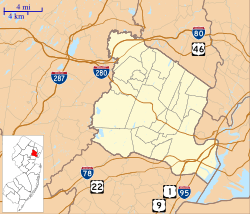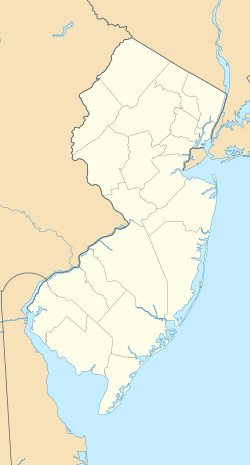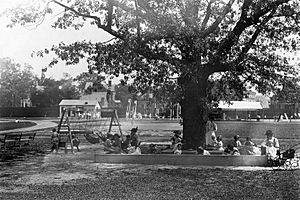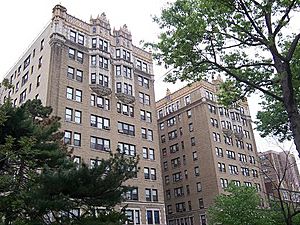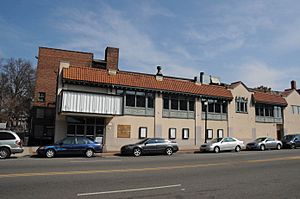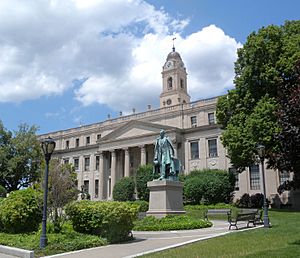East Orange, New Jersey facts for kids
Quick facts for kids
East Orange, New Jersey
|
||
|---|---|---|
|
City
|
||
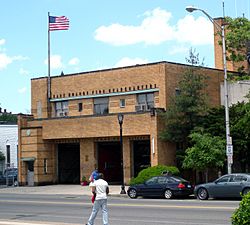
East Orange Fire Headquarters
|
||
|
||
| Country | ||
| State | ||
| County | Essex | |
| Incorporated | March 4, 1863 | |
| Government | ||
| • Type | City | |
| • Body | City Council | |
| Area | ||
| • Total | 3.93 sq mi (10.17 km2) | |
| • Land | 3.93 sq mi (10.17 km2) | |
| • Water | 0.00 sq mi (0.00 km2) 0.00% | |
| Area rank | 301st of 565 in state 10th of 22 in county |
|
| Elevation | 177 ft (54 m) | |
| Population
(2020)
|
||
| • Total | 69,612 | |
| • Estimate
(2024)
|
71,850 | |
| • Rank | 544th in country (as of 2023) 17th of 565 in state 2nd of 22 in county |
|
| • Density | 17,722.0/sq mi (6,842.5/km2) | |
| • Density rank | 13th of 565 in state 2nd of 22 in county |
|
| Time zone | UTC−05:00 (Eastern (EST)) | |
| • Summer (DST) | UTC−04:00 (Eastern (EDT)) | |
| ZIP Codes |
07017–07019
|
|
| Area code(s) | 973 | |
| FIPS code | 3401319390 | |
| GNIS feature ID | 0885200 | |
East Orange is a city located in Essex County, New Jersey. It's a vibrant place with a rich history. In 2020, about 69,612 people lived here. This made it the 17th most populated city in New Jersey.
Contents
History of East Orange
East Orange began with families from Connecticut in 1666. They traveled to the "Passayak" River area. This land now includes cities like Newark and the Oranges. King Charles II of England gave this land to his brother, James, Duke of York. James then gave it to Lord John Berkeley and Sir George Carteret. Since Carteret was the Royal Governor of the Isle of Jersey, the land became known as New Jersey.
East Orange was first part of Newark and called Newark Mountains. In 1780, the people of Newark Mountains voted to call their town Orange. Many wanted to separate from Newark. This finally happened in 1806. In 1807, the first local government was chosen. Orange officially became a city in 1860.
Soon after, the city started to split into smaller towns. This happened because of disagreements over paying for police, fire, and street services. South Orange formed in 1861, East Orange in 1863, and West Orange in 1863. East Orange became a city again in 1899 after a public vote. The city was once famous for the many shade trees lining its streets, and many of these old trees still stand today.
Geography and Location
East Orange covers about 3.93 square miles (10.17 square kilometers) of land. It doesn't have any water within its borders.
The city shares its borders with several other towns in Essex County. To the east and south, it borders Newark. To the southwest, it's next to South Orange. To the west, you'll find Orange. To the north, East Orange borders Glen Ridge and Bloomfield.
Exploring East Orange's Neighborhoods
East Orange is divided into five official areas called wards. It also has several unofficial neighborhoods, many with well-kept streets and homes.
- Ampere: This area grew around the old Ampere train station. It was named after André-Marie Ampère, a scientist who studied electricity.
- Greenwood (Teen Streets): This area is named after Greenwood Avenue and the "teen" streets that cross it. It was changed a lot when Interstate 280 and the Garden State Parkway were built.
- Presidential Estates: This neighborhood is known for its streets named after early U.S. presidents. It has many large, beautiful homes and old shade trees.
- Elmwood: Located in the southeast, Elmwood Park is a great spot here. It has tennis courts, a basketball court, a swimming pool, and sports fields. The Elmwood Branch of the East Orange Public Library, a Carnegie Library, opened in 1912.
- Doddtown (Franklin): Named after John Dodd, who first explored this area. The former Upsala College campus is here. It is now home to the East Orange Campus High School and new houses.
Population and People
East Orange has a diverse population. In 2020, the city's population was 69,612. This was an increase from 64,270 people in 2010.
Population Changes Over Time
| Race / Ethnicity (NH = Non-Hispanic) | Pop 1990 | Pop 2000 | Pop 2010 | Pop 2020 | % 1990 | % 2000 | % 2010 | % 2020 |
|---|---|---|---|---|---|---|---|---|
| White alone (NH) | 4,596 | 1,874 | 1,422 | 1,388 | 6.25% | 2.68% | 2.21% | 1.99% |
| Black or African American alone (NH) | 65,098 | 61,604 | 55,702 | 54,689 | 88.51% | 88.23% | 86.67% | 78.56% |
| Native American or Alaska Native alone (NH) | 287 | 130 | 186 | 164 | 0.39% | 0.19% | 0.29% | 0.24% |
| Asian alone (NH) | 449 | 294 | 436 | 501 | 0.61% | 0.42% | 0.68% | 0.72% |
| Native Hawaiian or Pacific Islander alone (NH) | N/A | 37 | 29 | 6 | N/A | 0.05% | 0.05% | 0.01% |
| Other race alone (NH) | 141 | 288 | 335 | 570 | 0.19% | 0.41% | 0.52% | 0.82% |
| Mixed race or Multiracial (NH) | N/A | 2,313 | 1,065 | 3,262 | N/A | 3.31% | 1.66% | 4.69% |
| Hispanic or Latino (any race) | 2,981 | 3,284 | 5,095 | 9,032 | 4.05% | 4.70% | 7.93% | 12.97% |
| Total | 73,552 | 69,824 | 64,270 | 69,612 | 100.00% | 100.00% | 100.00% | 100.00% |
In 2010, there were 64,270 people living in East Orange. About 29% of households had children under 18. The average household had 2.53 people. The median age was 35 years old.
In 2000, East Orange had 69,824 residents. A large percentage, 89.46%, identified as Black or African American. Many people from the Caribbean, like Jamaica, Trinidad and Tobago, Guyana, and Haiti, live in East Orange. The city has one of the highest percentages of African American and Caribbean American people in the United States.
Economy and Business
East Orange is part of an Urban Enterprise Zone (UEZ). This program helps encourage jobs and investment in the city. Shoppers in these zones can pay a lower sales tax rate. East Orange joined this program in 1996, and it will continue until June 2027.
The main shopping streets are Central Avenue and Main Street. Efforts have been made to improve these areas. New apartment buildings and shops have been built or planned recently.
Parks and Fun Activities
East Orange has five parks for residents to enjoy: Columbian Park, Elmwood Park, Francis-Haire Park, Memorial Park, and Rowley Park. There are also sports fields like Oval Playground and Soverel Field, which is the city's largest. Paul Robeson Stadium hosts local sports and the city's yearly Fourth of July fireworks show.
The city also owns the East Orange Golf Course, which is about 10 miles away in Short Hills.
City Government
East Orange is run by a mayor and a city council. The mayor is chosen by the voters. The city council has ten members, with two from each of the city's five wards. Council members serve four-year terms.
The City Council makes laws and approves the city's budget. The current mayor of East Orange is Theodore R. "Ted" Green, a Democrat. His term ends on December 31, 2025.
The first African-American Mayor of East Orange was William S. Hart Sr. He served from 1970 to 1978. Hart Middle School is named after him.
Voting and Politics
As of March 2011, most registered voters in East Orange were Democrats. In recent presidential elections, East Orange voters have strongly supported Democratic candidates. For example, in the 2012 election, Barack Obama received 98.5% of the votes.
Education in East Orange
The East Orange School District serves students from pre-kindergarten through 12th grade. The district has 20 schools. In the 2018–19 school year, there were over 10,000 students.
Some of the schools include:
- Althea Gibson Early Childhood Academy
- Whitney E. Houston Academy of Creative & Performing Arts
- East Orange Campus High School
- Cicely Tyson School of Performing and Fine Arts
The East Orange Public Library has a large collection of books and other items. It has four locations. The original library building opened in 1903, thanks to a gift from Andrew Carnegie.
Healthcare Services
East Orange has East Orange General Hospital, now called CareWell Health Medical Center. It's a hospital that provides general medical care. The city is also home to the US Department of Veterans Affairs Medical Center, also known as the East Orange VA Hospital. This hospital serves many veterans from the area.
Getting Around East Orange
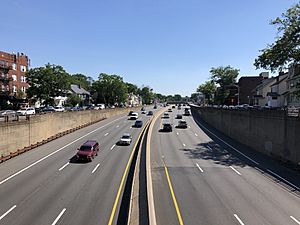
East Orange has many roads and highways. The Garden State Parkway and Interstate 280 are major highways that pass through the city.
Public Transportation Options
NJ Transit provides public bus services throughout East Orange and to nearby towns. There are many bus routes available.
New Jersey Transit also has two train stations in East Orange on the Morris & Essex Lines:
- East Orange station
- Brick Church station
Both stations offer train service to New York Penn Station in Midtown Manhattan. You can also get to Hoboken Terminal on weekdays.
The city is also close to Newark Liberty International Airport, which is about 7.8 miles away.
Famous People from East Orange
Many well-known people have connections to East Orange, including:
- Dionne Warwick (born 1940), a famous singer and TV host.
- John Amos (1939–2024), an actor.
- Althea Gibson (1927–2003), a groundbreaking tennis player.
- Lauryn Hill (born 1975), a singer-songwriter and actress.
- Whitney Houston (1963–2012), a world-famous singer and actress.
- Monte Irvin (1919–2016), a Major League Baseball player and Hall of Famer.
- Malcolm Jenkins (born 1987), a football player for the Philadelphia Eagles.
- Queen Latifah (born 1970), a rapper, singer, and actress.
- Naughty by Nature (music group), a hip hop trio.
- Jabrill Peppers (born 1995), a football player for the New York Giants.
- Richard Thaler (born 1945), an economist who won a Nobel Prize.
See also
 In Spanish: East Orange para niños
In Spanish: East Orange para niños



